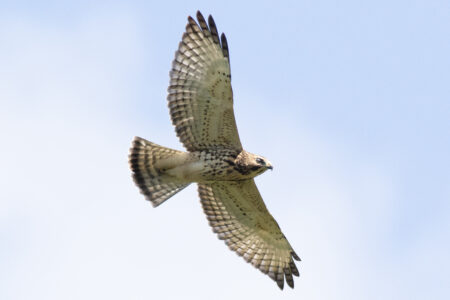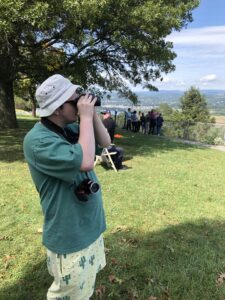GETTING HOOKED: Hawk watching can be an addictive, yet fun, hobby for birders
- PHOTO PROVIDED A broad-winged hawk is shown flying by the lookout in this photo by David Brown of the Cornell Lab of Ornithology.
- PHOTO PROVIDED Micah and Josiah Bauman walk on Stone Mountain by a sign indicating a spot to watch hawks in this photo by David Bauman.
- PHOTO PROVIDED Micah Bauman looks through binoculars at the Route 15 lookout for hawks in this photo by David Bauman.
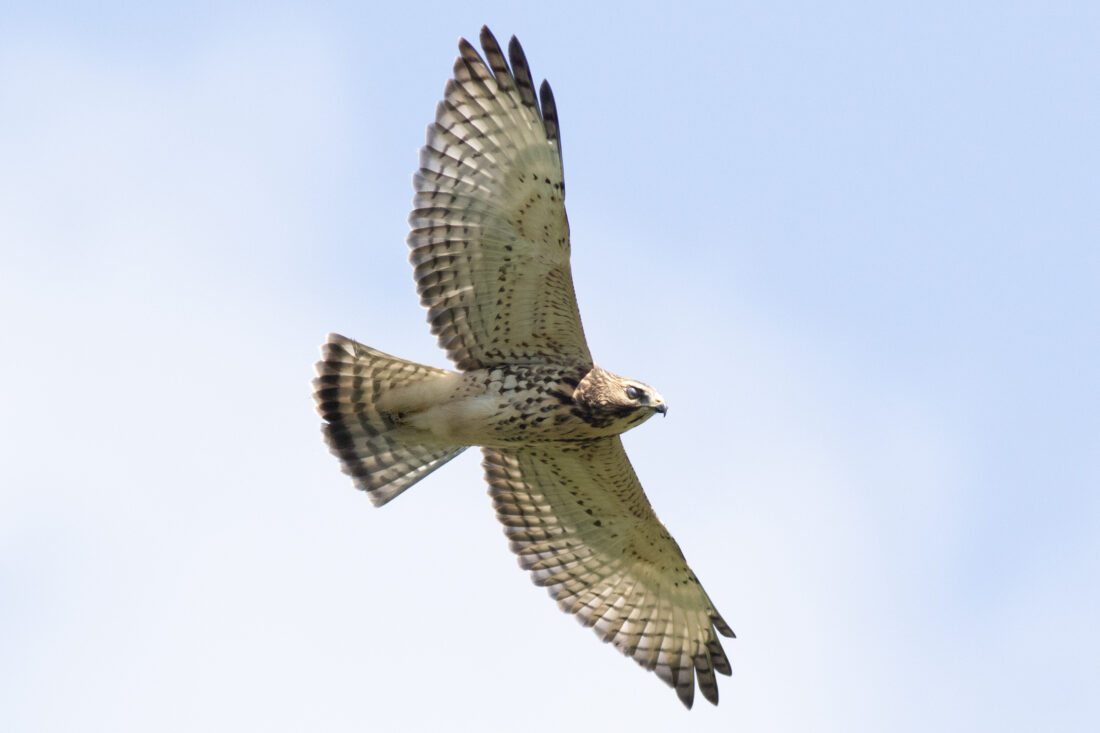
PHOTO PROVIDED A broad-winged hawk is shown flying by the lookout in this photo by David Brown of the Cornell Lab of Ornithology.
Watch your step but don’t forget to look up. I frequently point out, to both patrons and employees, the chimney swifts who chitter and circle overhead all summer long, not to mention frequent bald eagles, turkey vultures and even now and then an osprey.
They’re all visible through the giant library windows where I work.
But I should warn you that if you do look up, you could get hooked on what you see. That’s what happened to me, and in my case it was birds of prey, starting with a lone red-tailed hawk.
The summer after my senior year, I went backpacking with a friend on the Black Forest Trail near Slate Run. We were lazy, so we just set up a base camp not far from the stream and made day hikes from there.
My best memory from that week was of a beautiful red-tailed hawk passing over the part of the stream we called our watering hole. The only reason I knew what to call it was because I’d heard the name somewhere, and this hawk had an unmistakably brick-red tail.
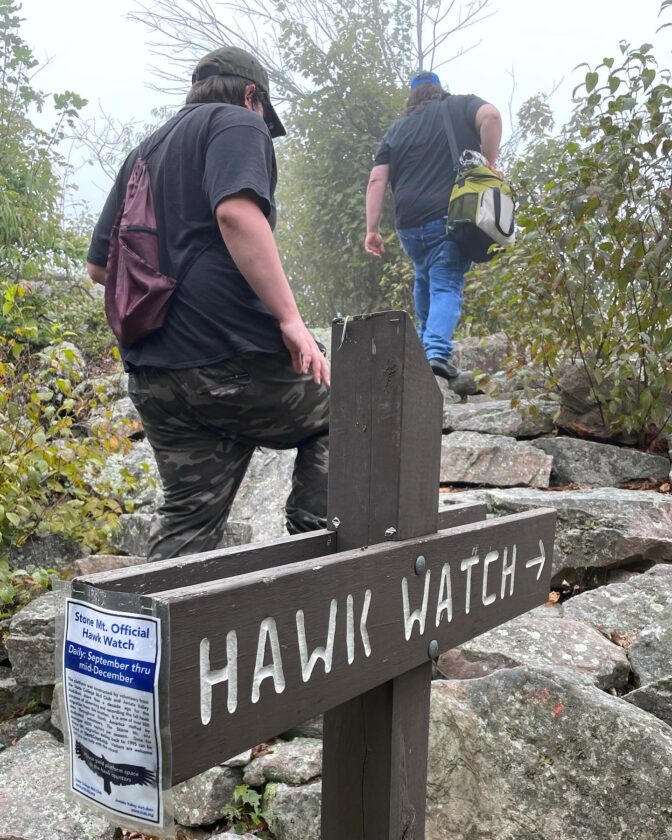
PHOTO PROVIDED Micah and Josiah Bauman walk on Stone Mountain by a sign indicating a spot to watch hawks in this photo by David Bauman.
The bird continued to soar in lazy circles overhead for several minutes and I was entranced.
I would soon learn at my local library by the way that not all red-tailed hawks have red tails, and here in the east, juveniles have thinly barred brown tails. I would also learn there were eight different species of hawks who regularly made their homes right here in Pennsylvania.
That’s not to mention three species of falcons, two of eagles, and the osprey in a class by itself.
Ironically, I was in the flat lands of Indiana, at school and feeling homesick when someone told me about a place called Hawk Mountain near Kempton. What I found at the university library was a book that changed my life, 40 years after it was published.
“Hawks Aloft: The Story of Hawk Mountain” by Maurice Braun, first printed in 1948, 15 years after he and his wife Irma arrived as the first curator and gate keeper, respectively, of the Hawk Mountain Sanctuary.
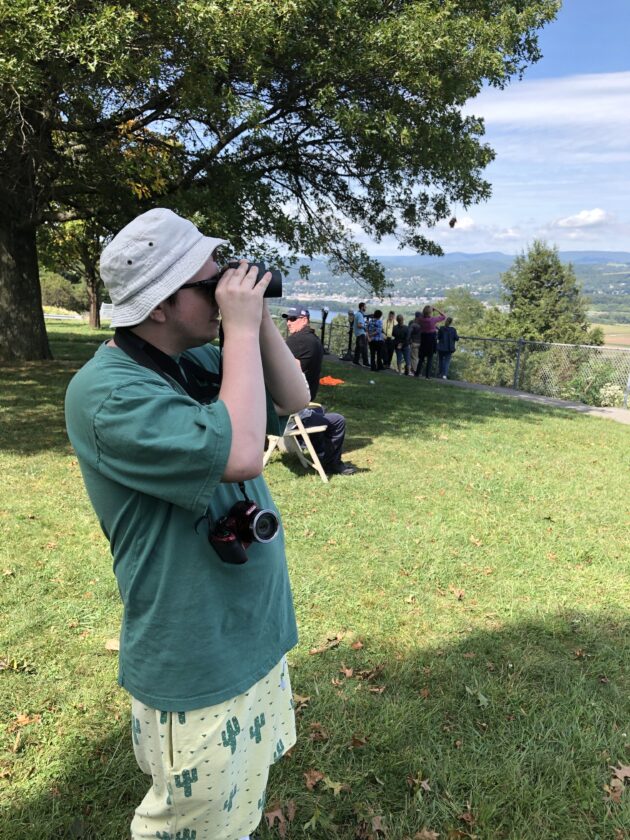
PHOTO PROVIDED Micah Bauman looks through binoculars at the Route 15 lookout for hawks in this photo by David Bauman.
This was new to me, the idea that there were migration hot spots. I learned that north-facing lookouts, particularly along ridgetops, had the potential to be good spots for observing migrating birds of prey. Generally sites that have a view up the ridge and into both the northwest and southeast valleys could serve as corridors for birds moving from their northern breeding spots to their winter homes in the south.
Picture a raised relief map of Pennsylvania on the wall in front of you. More or less from the center to the southeast, is the ridge and valley region. Now imagine you’re a hawk flying south after a cold front. The updrafts off those ridges, along with rising columns of warm air called thermals, can provide you an easier flight south.
More gliding and soaring, less energy expended.
When I moved back east, I headed to spots like Hawk Mountain and Waggoner’s Gap, positioned myself near hawk counters on fall weekends, where I’d listen, observe and ask questions. I even took my nervous knees up the steps of a fire tower near State College before meeting Greg Grove on Stone Mountain.
There we watched from lawn chairs behind our cars at the bend in the road. That was before the viewing deck was built on the top of the ridge.
Grove took me under his wing and suggested good but affordable optics. When he’d quiz me on a bird that flew over, if I said sharp-shinned hawk, he’d say, “OK, now tell me why.” I owe so much to people like Grove, and it was a joy to introduce him to my sons when we visited the hawk watch recently.
If you want to treat yourself to some hawk watching, September is an excellent time to start when broad-winged hawks tend to travel in groups. You could hike out onto Bake Oven Knob or park at Jack’s Mountain below the altar. Even the purely north-facing view at the Route 15 lookout above Montoursville can be surprisingly good when there are northerly winds.
Go to HawkCount.org and click on the map to find the closest hawk watch and see for yourself. And if it’s a slow bird day, just enjoy the view.
It’s like what they say about fishing: a bad day of hawk watching is better than a good day at work.
David Bauman began his birding journey by frequenting hawk watch sites in the late 1980s and early 1990s. Gradually he realized there were so many more birds. He is the executive director of Snyder County Libraries and a county co-coordinator for the Pennsylvania Bird Atlas. You can find more of his poetry and prose at DavidJBauman.com.

